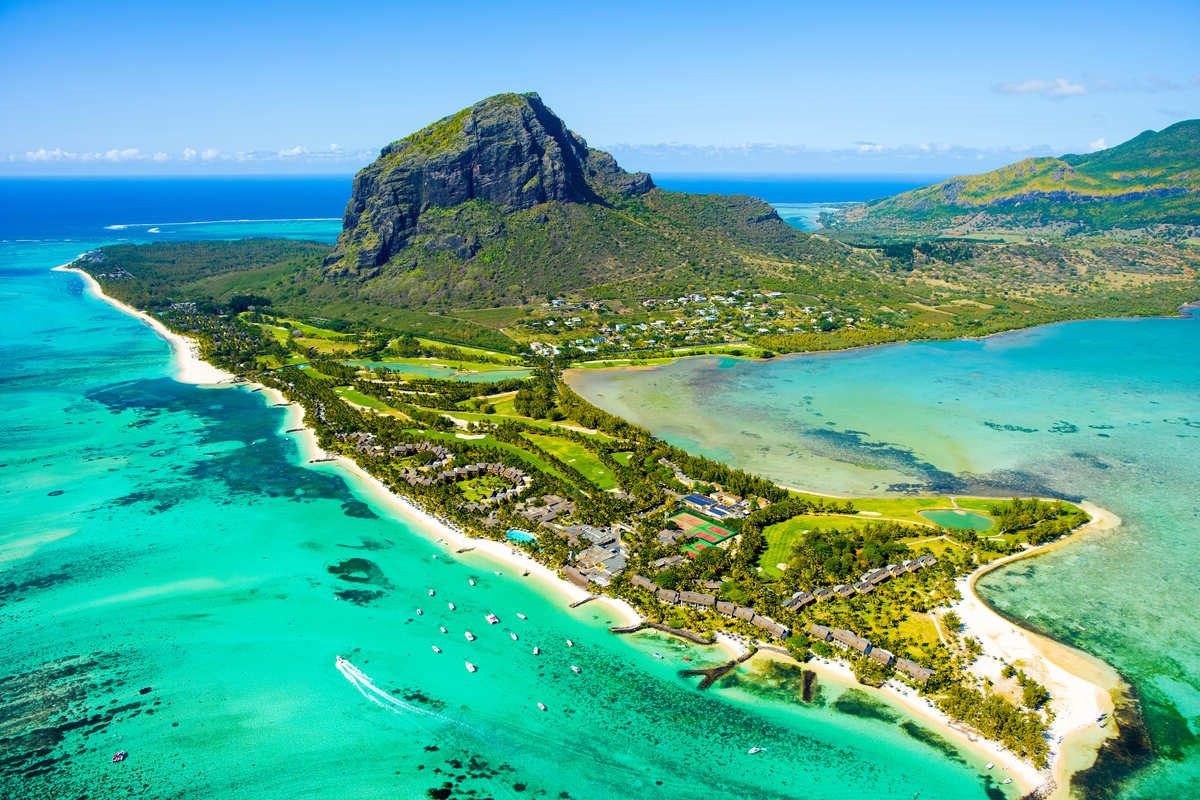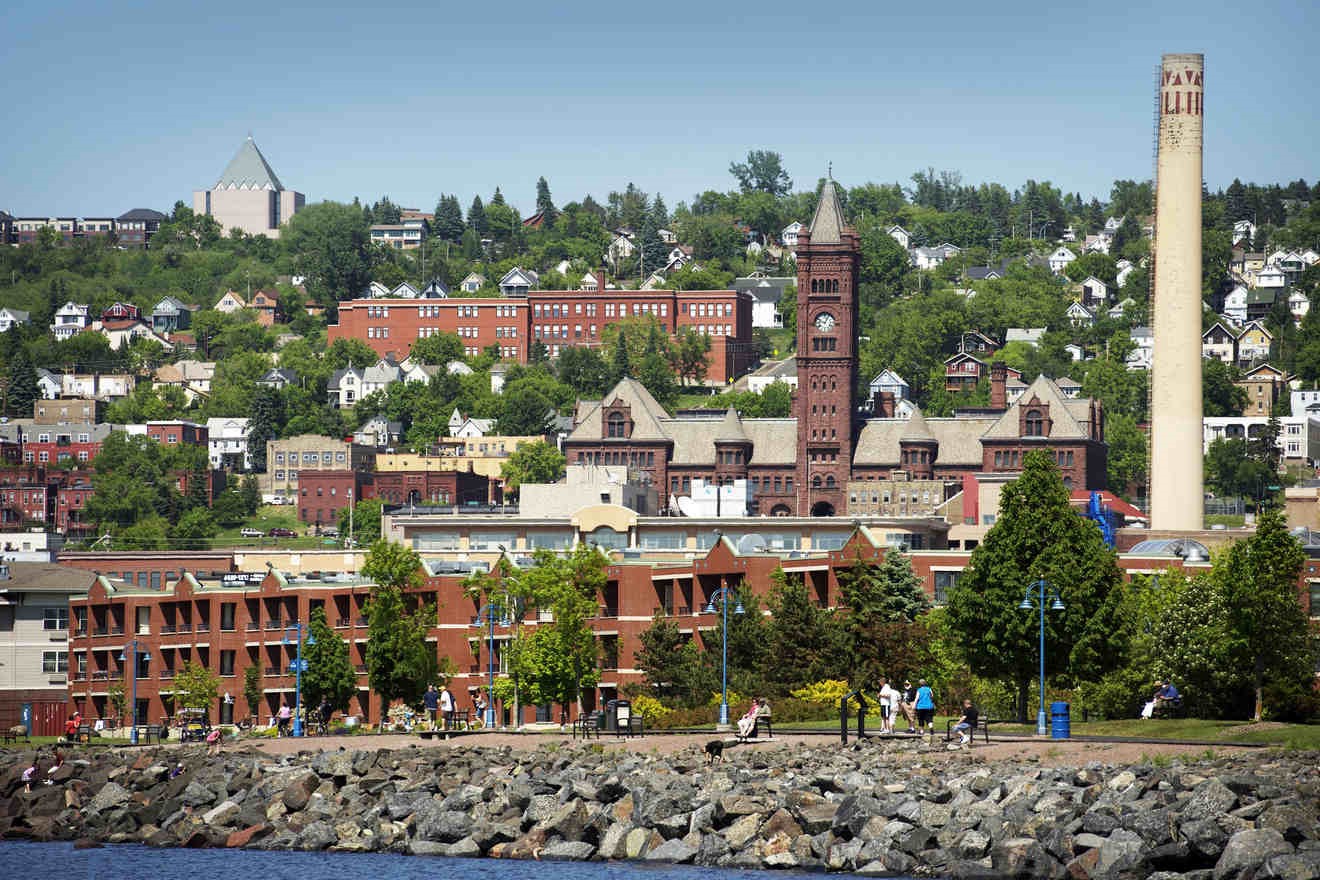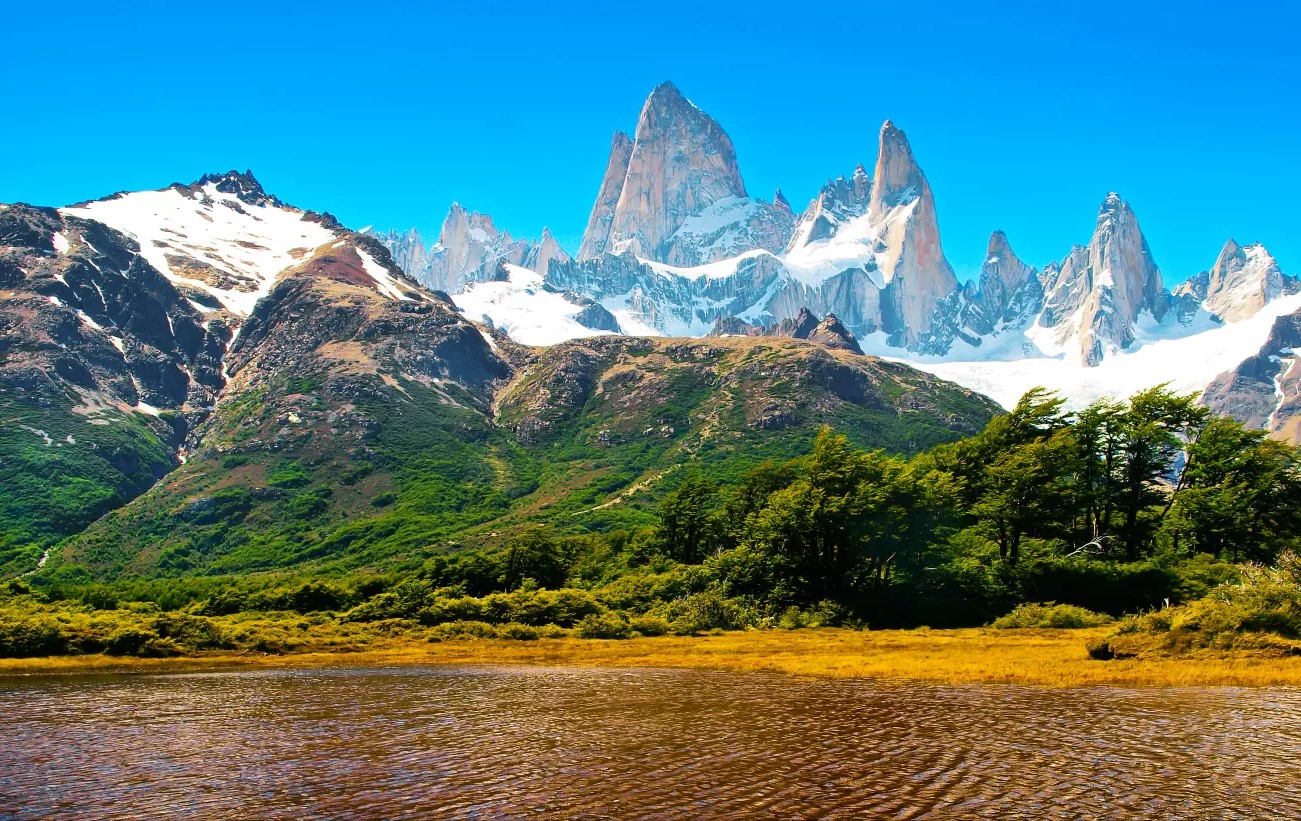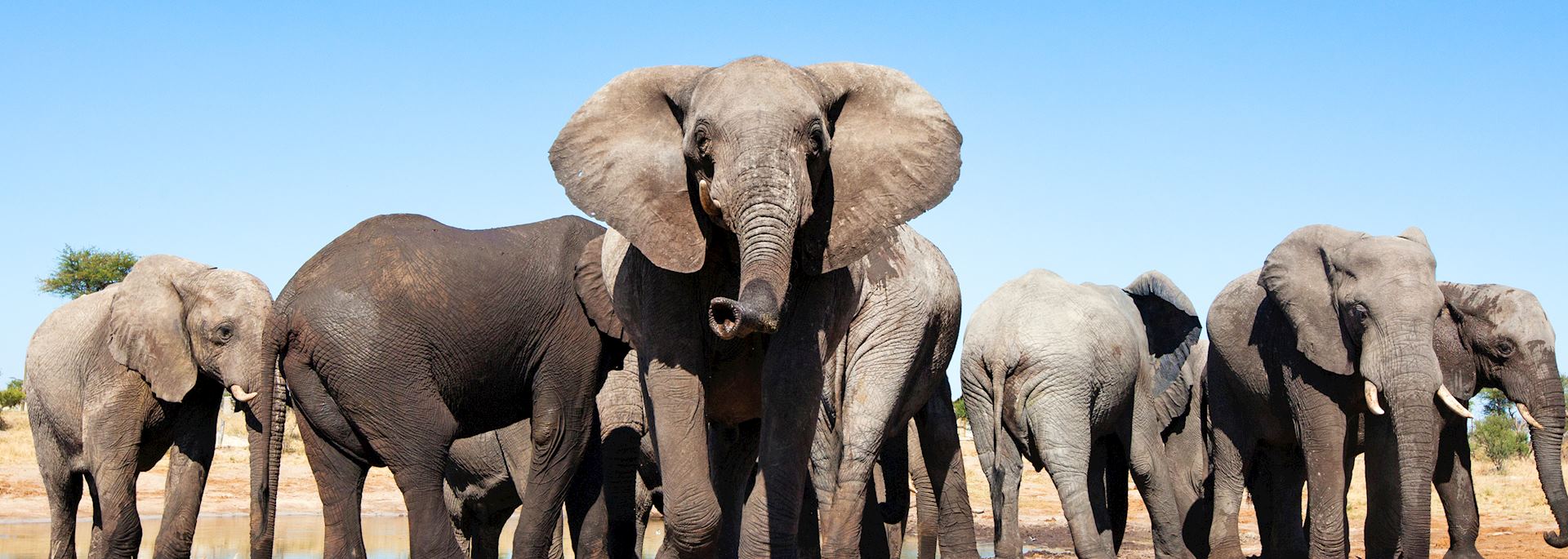Home>Weather and Climate>South Africa Weather: Monthly Climate Guide


Weather and Climate
South Africa Weather: Monthly Climate Guide
Published: March 5, 2024
Plan your trip with our comprehensive South Africa weather and climate guide. Explore monthly weather patterns and make the most of your visit.
(Many of the links in this article redirect to a specific reviewed product. Your purchase of these products through affiliate links helps to generate commission for Temperatures.com, at no extra cost. Learn more)
Table of Contents
Introduction
South Africa is a land of diverse landscapes, rich cultural heritage, and a wide range of climates. From the stunning coastline to the majestic mountains and sprawling savannas, the country offers a tapestry of weather patterns that vary from region to region and season to season. Understanding the climate of South Africa is essential for anyone planning a visit or seeking to gain insight into this captivating country's natural rhythms.
The weather in South Africa is influenced by a variety of factors, including its position in the Southern Hemisphere, its proximity to the Atlantic and Indian Oceans, and the topographical diversity across the country. These elements combine to create a fascinating mosaic of climates, from the arid deserts of the west to the lush forests of the east.
In this comprehensive guide, we will delve into the monthly climate patterns of South Africa, providing valuable insights into the temperatures, precipitation, and overall weather conditions that shape each month. Whether you're an avid traveler, a nature enthusiast, or simply curious about the climate of this remarkable country, this guide will offer a detailed and informative exploration of South Africa's weather throughout the year.
Let's embark on a journey through the changing seasons and diverse climates of South Africa, gaining a deeper understanding of the natural forces that shape this captivating land.
Read more: Monthly Temperature Guide for South Africa
Weather Patterns in South Africa
South Africa's weather patterns are as diverse as the country itself, encompassing a wide range of climates that vary from region to region. The country's geographical location in the Southern Hemisphere plays a significant role in shaping its weather, with the seasons occurring opposite to those in the Northern Hemisphere. South Africa's proximity to the Atlantic and Indian Oceans further influences its climate, bringing about distinct weather patterns along the coastline and inland areas.
The western regions of South Africa are characterized by arid and semi-arid climates, with the Namib Desert extending into the northwestern part of the country. These areas experience low precipitation and are known for their vast expanses of desert landscapes. Moving eastward, the climate transitions into a Mediterranean-type climate, with mild, wet winters and hot, dry summers. The southern coastlines are influenced by the cold Benguela Current, resulting in cooler temperatures and lower rainfall compared to the eastern coast, which is affected by the warm Agulhas Current.
Inland, the climate varies from the temperate highveld of the interior plateau to the subtropical and tropical climates of the northeastern regions. The highveld experiences distinct seasons, with cold, dry winters and hot, rainy summers. The northeastern provinces, including Mpumalanga and Limpopo, have a more tropical climate, characterized by hot, humid conditions and summer rainfall.
South Africa's topographical diversity also contributes to its weather patterns, with the Drakensberg Mountains influencing the climate in the eastern regions and the Kalahari Desert impacting the weather in the central and northwestern areas. These varied landscapes give rise to microclimates, adding further complexity to the country's weather patterns.
Overall, South Africa's weather patterns are a reflection of its diverse geography, with each region offering a unique climate experience. Understanding these weather patterns is essential for travelers and locals alike, as it allows for better preparation and appreciation of the natural beauty that unfolds across the country throughout the year.
January Climate
January marks the height of summer in South Africa, bringing with it warm temperatures and abundant sunshine across much of the country. As the Southern Hemisphere experiences its peak summer season, South Africa basks in the glow of long, sun-drenched days and balmy evenings. The climate during this month varies across different regions, offering a diverse range of experiences for visitors and locals alike.
Along the coastal areas, particularly in the eastern provinces of KwaZulu-Natal and the Eastern Cape, January brings hot and humid conditions. The warm waters of the Indian Ocean contribute to the sultry climate, creating ideal conditions for beachgoers and water sports enthusiasts. The coastal regions experience temperatures ranging from the mid-20s to low 30s degrees Celsius (mid-70s to low 90s degrees Fahrenheit), making it a popular time for seaside vacations and outdoor activities.
Inland, the highveld regions, including Johannesburg and Pretoria, experience warm and occasionally thundery conditions during January. Daytime temperatures typically reach the high 20s to low 30s degrees Celsius (mid-70s to low 90s degrees Fahrenheit), providing a pleasant environment for outdoor exploration and sightseeing. The occasional afternoon thunderstorms bring relief from the heat and add a dramatic flair to the summer skies.
Further north, in the Limpopo and Mpumalanga provinces, January heralds the peak of the rainy season. The tropical climate in these regions brings hot, humid days and frequent afternoon thunderstorms, contributing to the lush greenery and vibrant landscapes. The combination of high temperatures and ample rainfall creates a fertile environment for the region's diverse flora and fauna, making it an ideal time for nature enthusiasts to witness the abundance of life in the area's national parks and reserves.
In the western parts of the country, including the Western Cape and Northern Cape, January brings warm and dry conditions, with minimal rainfall and clear skies. The Mediterranean-type climate in these regions offers a stark contrast to the humid conditions experienced in other parts of the country, providing an excellent opportunity for outdoor activities such as hiking, wine tasting, and exploring the breathtaking coastal scenery.
Overall, January showcases the diversity of South Africa's climate, offering a spectrum of experiences for visitors and locals to enjoy. Whether seeking sun-soaked beach days, adventurous wildlife encounters, or tranquil mountain retreats, the country's varied climate in January provides something for everyone to savor amidst the height of the Southern Hemisphere summer.
February Climate
February brings a continuation of the warm and vibrant summer conditions to South Africa, offering a delightful tapestry of climates across the country. As the peak of the summer season persists, February presents an array of experiences for visitors and locals, with each region showcasing its unique climate characteristics.
Along the eastern coastline, encompassing the provinces of KwaZulu-Natal and the Eastern Cape, February maintains its hot and humid climate, drawing beach enthusiasts and water lovers to the shores. The warm waters of the Indian Ocean provide an inviting backdrop for swimming, surfing, and coastal relaxation. The temperatures typically range from the mid-20s to low 30s degrees Celsius (mid-70s to low 90s degrees Fahrenheit), creating an idyllic setting for seaside escapades and outdoor leisure activities.
Inland, the highveld regions, including Johannesburg and Pretoria, continue to experience warm and occasionally thundery conditions during February. Daytime temperatures hover in the high 20s to low 30s degrees Celsius (mid-70s to low 90s degrees Fahrenheit), offering pleasant weather for exploring the urban landscapes and engaging in outdoor pursuits. The occasional afternoon thunderstorms punctuate the skies, providing refreshing relief from the summer heat and adding a touch of drama to the atmospheric canvas.
Moving northward to the Limpopo and Mpumalanga provinces, February marks the peak of the rainy season, sustaining the tropical climate with hot, humid days and frequent afternoon thunderstorms. The lush greenery and vibrant landscapes continue to thrive under the combination of high temperatures and ample rainfall, creating an enchanting environment for nature enthusiasts and wildlife aficionados to immerse themselves in the region's natural splendor.
In the western regions, including the Western Cape and Northern Cape, February maintains its warm and dry conditions, with minimal rainfall and clear skies dominating the landscape. The Mediterranean-type climate in these areas provides an ideal setting for outdoor pursuits such as hiking, wine tasting, and exploring the picturesque coastal vistas, allowing visitors to revel in the tranquil beauty of the region.
Overall, February in South Africa encapsulates the essence of summer, offering a diverse array of climates that cater to a wide range of interests and preferences. Whether seeking coastal adventures, urban exploration, or nature immersion, the country's varied climate in February sets the stage for memorable experiences amidst the peak of the Southern Hemisphere summer.
March Climate
March heralds the transition from summer to autumn in South Africa, bringing a shift in the country's climate as it prepares for the arrival of the cooler months. This month offers a fascinating blend of weather patterns across different regions, providing a diverse tapestry of experiences for visitors and locals alike.
Along the eastern coastline, encompassing the provinces of KwaZulu-Natal and the Eastern Cape, March maintains its warm and humid climate, creating an inviting atmosphere for beach enthusiasts and outdoor enthusiasts. The Indian Ocean's waters retain their warmth, offering an ideal setting for swimming, surfing, and coastal relaxation. The temperatures typically range from the mid-20s to low 30s degrees Celsius (mid-70s to low 90s degrees Fahrenheit), providing a comfortable environment for seaside activities and leisurely pursuits.
Inland, the highveld regions, including Johannesburg and Pretoria, experience a gradual transition to milder temperatures as autumn approaches. Daytime temperatures begin to moderate, ranging from the high teens to mid-20s degrees Celsius (mid-60s to high 70s degrees Fahrenheit), creating pleasant conditions for outdoor exploration and urban adventures. The occasional afternoon thunderstorms may still punctuate the skies, adding a touch of drama to the evolving weather patterns.
Moving northward to the Limpopo and Mpumalanga provinces, March marks the latter part of the rainy season, sustaining the tropical climate with warm days and intermittent afternoon showers. The lush landscapes continue to thrive under the lingering combination of high temperatures and moderate rainfall, offering a captivating backdrop for nature enthusiasts and wildlife aficionados to immerse themselves in the region's natural beauty.
In the western regions, including the Western Cape and Northern Cape, March signals the gradual transition to cooler and milder conditions as autumn takes hold. The Mediterranean-type climate in these areas brings comfortable temperatures, ranging from the high teens to low 20s degrees Celsius (mid-60s to low 70s degrees Fahrenheit), providing an ideal setting for outdoor activities such as hiking, wine tasting, and exploring the scenic coastal vistas.
Overall, March in South Africa encapsulates the dynamic shift from summer to autumn, offering a diverse array of climates that cater to a wide range of interests and preferences. Whether seeking coastal relaxation, urban exploration, or nature immersion, the country's varied climate in March sets the stage for memorable experiences amidst the transition to the cooler months.
Read more: South Africa Weather Guide for August
April Climate
April marks the onset of autumn in South Africa, signaling a transition from the warm summer months to the cooler and crisper conditions that characterize the approaching winter season. This month brings a fascinating interplay of weather patterns across the country, offering a diverse range of experiences for visitors and locals as they embrace the changing climate.
Along the eastern coastline, encompassing the provinces of KwaZulu-Natal and the Eastern Cape, April ushers in milder temperatures as the summer heat gradually gives way to cooler conditions. The coastal regions experience comfortable weather, with daytime temperatures ranging from the high teens to low 20s degrees Celsius (mid-60s to low 70s degrees Fahrenheit), creating an inviting atmosphere for outdoor activities and coastal exploration. The Indian Ocean retains its warmth, providing a pleasant backdrop for beachgoers and water enthusiasts to savor the idyllic coastal settings.
Inland, the highveld regions, including Johannesburg and Pretoria, embrace the autumnal shift with mild and temperate conditions. Daytime temperatures moderate further, ranging from the mid-teens to low 20s degrees Celsius (high 50s to low 70s degrees Fahrenheit), offering an ideal environment for outdoor pursuits and urban adventures. The occasional afternoon showers may occur, adding a refreshing touch to the evolving weather patterns and contributing to the changing landscapes.
Moving northward to the Limpopo and Mpumalanga provinces, April signifies the latter part of the rainy season, sustaining the tropical climate with warm days and intermittent showers. The lush greenery continues to thrive under the lingering combination of moderate temperatures and sporadic rainfall, creating a captivating backdrop for nature enthusiasts and wildlife aficionados to immerse themselves in the region's natural beauty.
In the western regions, including the Western Cape and Northern Cape, April brings cooler and milder conditions as autumn takes hold. The Mediterranean-type climate in these areas offers comfortable temperatures, ranging from the mid-teens to low 20s degrees Celsius (high 50s to low 70s degrees Fahrenheit), providing an ideal setting for outdoor activities such as hiking, wine tasting, and exploring the scenic coastal vistas.
Overall, April in South Africa presents a captivating transition from summer to autumn, offering a diverse array of climates that cater to a wide range of interests and preferences. Whether seeking coastal relaxation, urban exploration, or nature immersion, the country's varied climate in April sets the stage for memorable experiences amidst the evolving seasons.
May Climate
May brings a notable shift in South Africa's climate as the country transitions further into the autumn season. This month offers a captivating interplay of weather patterns across different regions, creating a diverse tapestry of experiences for visitors and locals alike.
Along the eastern coastline, encompassing the provinces of KwaZulu-Natal and the Eastern Cape, May ushers in cooler temperatures as the autumnal ambiance takes hold. The coastal regions experience mild weather, with daytime temperatures ranging from the mid-teens to low 20s degrees Celsius (high 50s to low 70s degrees Fahrenheit), providing an inviting atmosphere for outdoor activities and coastal exploration. The Indian Ocean retains its allure, offering a serene backdrop for beachgoers and nature enthusiasts to savor the tranquil coastal settings.
Inland, the highveld regions, including Johannesburg and Pretoria, embrace the autumnal transition with mild and temperate conditions. Daytime temperatures continue to moderate, ranging from the mid-teens to low 20s degrees Celsius (high 50s to low 70s degrees Fahrenheit), creating an ideal environment for outdoor pursuits and urban adventures. The occasional showers may occur, adding a refreshing touch to the evolving weather patterns and contributing to the changing landscapes.
Moving northward to the Limpopo and Mpumalanga provinces, May signifies the waning of the rainy season, with the tropical climate embracing milder temperatures and reduced rainfall. The lush greenery continues to thrive under the moderate temperatures, creating a captivating backdrop for nature enthusiasts and wildlife aficionados to immerse themselves in the region's natural beauty.
In the western regions, including the Western Cape and Northern Cape, May brings cooler and milder conditions as autumn unfolds. The Mediterranean-type climate in these areas offers comfortable temperatures, ranging from the mid-teens to low 20s degrees Celsius (high 50s to low 70s degrees Fahrenheit), providing an ideal setting for outdoor activities such as hiking, wine tasting, and exploring the scenic coastal vistas.
Overall, May in South Africa presents a captivating transition from autumn to winter, offering a diverse array of climates that cater to a wide range of interests and preferences. Whether seeking coastal relaxation, urban exploration, or nature immersion, the country's varied climate in May sets the stage for memorable experiences amidst the evolving seasons.
June Climate
June marks the arrival of winter in South Africa, bringing a notable shift in the country's climate as cooler temperatures and distinct weather patterns unfold across the diverse regions. This month offers a captivating interplay of seasonal transitions, creating a unique tapestry of experiences for visitors and locals alike.
Along the eastern coastline, encompassing the provinces of KwaZulu-Natal and the Eastern Cape, June ushers in the cool embrace of winter. The coastal regions experience mild and crisp weather, with daytime temperatures ranging from the mid-teens to low 20s degrees Celsius (high 50s to low 70s degrees Fahrenheit), creating an inviting atmosphere for outdoor activities and coastal exploration. The Indian Ocean retains its tranquil allure, offering a serene backdrop for beachgoers and nature enthusiasts to savor the peaceful coastal settings.
Inland, the highveld regions, including Johannesburg and Pretoria, embrace the winter season with cool and crisp conditions. Daytime temperatures continue to moderate, ranging from the mid-teens to low 20s degrees Celsius (high 50s to low 70s degrees Fahrenheit), creating an ideal environment for outdoor pursuits and urban adventures. The occasional showers may occur, adding a refreshing touch to the evolving weather patterns and contributing to the changing landscapes.
Moving northward to the Limpopo and Mpumalanga provinces, June signifies the transition to the dry winter season, with the tropical climate embracing cooler temperatures and reduced rainfall. The landscapes retain their lush greenery, offering a captivating backdrop for nature enthusiasts and wildlife aficionados to immerse themselves in the region's natural beauty.
In the western regions, including the Western Cape and Northern Cape, June brings cooler and milder conditions as winter takes hold. The Mediterranean-type climate in these areas offers comfortable temperatures, ranging from the mid-teens to low 20s degrees Celsius (high 50s to low 70s degrees Fahrenheit), providing an ideal setting for outdoor activities such as hiking, wine tasting, and exploring the scenic coastal vistas.
Overall, June in South Africa presents a captivating transition to the winter season, offering a diverse array of climates that cater to a wide range of interests and preferences. Whether seeking coastal relaxation, urban exploration, or nature immersion, the country's varied climate in June sets the stage for memorable experiences amidst the evolving seasons.
July Climate
July brings the heart of winter to South Africa, marking a significant shift in the country's climate as cooler temperatures and distinct weather patterns unfold across the diverse regions. This month offers a captivating interplay of seasonal transitions, creating a unique tapestry of experiences for visitors and locals alike.
Along the eastern coastline, encompassing the provinces of KwaZulu-Natal and the Eastern Cape, July embraces the cool embrace of winter. The coastal regions experience crisp and invigorating weather, with daytime temperatures ranging from the mid-teens to low 20s degrees Celsius (high 50s to low 70s degrees Fahrenheit), creating an inviting atmosphere for outdoor activities and coastal exploration. The Indian Ocean retains its tranquil allure, offering a serene backdrop for beachgoers and nature enthusiasts to savor the peaceful coastal settings.
Inland, the highveld regions, including Johannesburg and Pretoria, embody the winter season with cool and crisp conditions. Daytime temperatures continue to moderate, ranging from the mid-teens to low 20s degrees Celsius (high 50s to low 70s degrees Fahrenheit), creating an ideal environment for outdoor pursuits and urban adventures. The occasional showers may occur, adding a refreshing touch to the evolving weather patterns and contributing to the changing landscapes.
Moving northward to the Limpopo and Mpumalanga provinces, July signifies the dry winter season, with the tropical climate embracing cooler temperatures and reduced rainfall. The landscapes retain their serene beauty, offering a captivating backdrop for nature enthusiasts and wildlife aficionados to immerse themselves in the region's natural splendor.
In the western regions, including the Western Cape and Northern Cape, July brings cooler and milder conditions as winter takes hold. The Mediterranean-type climate in these areas offers comfortable temperatures, ranging from the mid-teens to low 20s degrees Celsius (high 50s to low 70s degrees Fahrenheit), providing an ideal setting for outdoor activities such as hiking, wine tasting, and exploring the scenic coastal vistas.
Overall, July in South Africa presents a captivating transition to the winter season, offering a diverse array of climates that cater to a wide range of interests and preferences. Whether seeking coastal relaxation, urban exploration, or nature immersion, the country's varied climate in July sets the stage for memorable experiences amidst the evolving seasons.
August Climate
August heralds the peak of winter in South Africa, bringing with it a distinctive shift in the country's climate as cooler temperatures and unique weather patterns unfold across the diverse regions. This month offers a captivating interplay of seasonal transitions, creating a unique tapestry of experiences for visitors and locals alike.
Along the eastern coastline, encompassing the provinces of KwaZulu-Natal and the Eastern Cape, August embraces the cool embrace of winter. The coastal regions experience crisp and invigorating weather, with daytime temperatures ranging from the mid-teens to low 20s degrees Celsius (high 50s to low 70s degrees Fahrenheit), creating an inviting atmosphere for outdoor activities and coastal exploration. The Indian Ocean retains its tranquil allure, offering a serene backdrop for beachgoers and nature enthusiasts to savor the peaceful coastal settings.
Inland, the highveld regions, including Johannesburg and Pretoria, embody the winter season with cool and crisp conditions. Daytime temperatures continue to moderate, ranging from the mid-teens to low 20s degrees Celsius (high 50s to low 70s degrees Fahrenheit), creating an ideal environment for outdoor pursuits and urban adventures. The occasional showers may occur, adding a refreshing touch to the evolving weather patterns and contributing to the changing landscapes.
Moving northward to the Limpopo and Mpumalanga provinces, August signifies the dry winter season, with the tropical climate embracing cooler temperatures and reduced rainfall. The landscapes retain their serene beauty, offering a captivating backdrop for nature enthusiasts and wildlife aficionados to immerse themselves in the region's natural splendor.
In the western regions, including the Western Cape and Northern Cape, August brings cooler and milder conditions as winter takes hold. The Mediterranean-type climate in these areas offers comfortable temperatures, ranging from the mid-teens to low 20s degrees Celsius (high 50s to low 70s degrees Fahrenheit), providing an ideal setting for outdoor activities such as hiking, wine tasting, and exploring the scenic coastal vistas.
Overall, August in South Africa presents a captivating continuation of the winter season, offering a diverse array of climates that cater to a wide range of interests and preferences. Whether seeking coastal relaxation, urban exploration, or nature immersion, the country's varied climate in August sets the stage for memorable experiences amidst the evolving seasons.
September Climate
September marks the gradual transition from winter to spring in South Africa, heralding a notable shift in the country's climate as warmer temperatures and rejuvenating weather patterns begin to emerge across the diverse regions. This month offers a captivating interplay of seasonal transformations, creating a unique tapestry of experiences for visitors and locals alike.
Along the eastern coastline, encompassing the provinces of KwaZulu-Natal and the Eastern Cape, September brings a delightful transition from the cool embrace of winter to the invigorating ambiance of spring. The coastal regions experience milder and pleasant weather, with daytime temperatures ranging from the high teens to low 20s degrees Celsius (mid-60s to low 70s degrees Fahrenheit), creating an inviting atmosphere for outdoor activities and coastal exploration. The Indian Ocean retains its allure, offering a serene backdrop for beachgoers and nature enthusiasts to savor the tranquil coastal settings.
Inland, the highveld regions, including Johannesburg and Pretoria, embrace the transition to spring with mild and temperate conditions. Daytime temperatures begin to moderate further, ranging from the high teens to low 20s degrees Celsius (mid-60s to low 70s degrees Fahrenheit), creating an ideal environment for outdoor pursuits and urban adventures. The occasional showers may occur, adding a refreshing touch to the evolving weather patterns and contributing to the changing landscapes as nature awakens from the winter slumber.
Moving northward to the Limpopo and Mpumalanga provinces, September signifies the onset of the spring season, with the tropical climate embracing warmer temperatures and the emergence of new growth. The landscapes begin to transform, displaying vibrant hues of green as flora and fauna come to life, offering a captivating backdrop for nature enthusiasts and wildlife aficionados to immerse themselves in the region's natural splendor.
In the western regions, including the Western Cape and Northern Cape, September brings a delightful transition to milder and more temperate conditions as spring unfolds. The Mediterranean-type climate in these areas offers comfortable temperatures, ranging from the high teens to low 20s degrees Celsius (mid-60s to low 70s degrees Fahrenheit), providing an ideal setting for outdoor activities such as hiking, wine tasting, and exploring the scenic coastal vistas as the landscapes undergo a rejuvenating transformation.
Overall, September in South Africa presents a captivating transition from winter to spring, offering a diverse array of climates that cater to a wide range of interests and preferences. Whether seeking coastal relaxation, urban exploration, or nature immersion, the country's varied climate in September sets the stage for memorable experiences amidst the evolving seasons.
October Climate
October heralds the arrival of spring in full bloom across South Africa, bringing a vibrant tapestry of rejuvenating weather patterns and a palpable sense of renewal to the diverse regions of the country. This month marks a captivating transition from the cooler winter months to the warmer and more invigorating conditions of spring, offering a delightful interplay of seasonal transformations that cater to a wide range of interests and preferences.
Along the eastern coastline, encompassing the provinces of KwaZulu-Natal and the Eastern Cape, October ushers in the enchanting embrace of spring. The coastal regions experience mild and pleasant weather, with daytime temperatures ranging from the high teens to low 20s degrees Celsius (mid-60s to low 70s degrees Fahrenheit), creating an inviting atmosphere for outdoor activities and coastal exploration. The Indian Ocean retains its allure, offering a serene backdrop for beachgoers and nature enthusiasts to savor the tranquil coastal settings as the landscapes burst into a kaleidoscope of colors.
Inland, the highveld regions, including Johannesburg and Pretoria, embrace the full bloom of spring with mild and temperate conditions. Daytime temperatures continue to moderate, ranging from the high teens to low 20s degrees Celsius (mid-60s to low 70s degrees Fahrenheit), creating an ideal environment for outdoor pursuits and urban adventures. The occasional showers may occur, adding a refreshing touch to the evolving weather patterns and contributing to the changing landscapes as nature awakens from the winter slumber, painting the surroundings with vibrant blossoms and lush foliage.
Moving northward to the Limpopo and Mpumalanga provinces, October signifies the peak of the spring season, with the tropical climate embracing warmer temperatures and the full emergence of new growth. The landscapes undergo a remarkable transformation, displaying an array of vibrant hues as flora and fauna come to life, offering a captivating backdrop for nature enthusiasts and wildlife aficionados to immerse themselves in the region's natural splendor.
In the western regions, including the Western Cape and Northern Cape, October brings a delightful transition to milder and more temperate conditions as spring unfolds in all its glory. The Mediterranean-type climate in these areas offers comfortable temperatures, ranging from the high teens to low 20s degrees Celsius (mid-60s to low 70s degrees Fahrenheit), providing an ideal setting for outdoor activities such as hiking, wine tasting, and exploring the scenic coastal vistas as the landscapes undergo a rejuvenating transformation.
Overall, October in South Africa presents a captivating celebration of spring, offering a diverse array of climates that cater to a wide range of interests and preferences. Whether seeking coastal relaxation, urban exploration, or nature immersion, the country's varied climate in October sets the stage for memorable experiences amidst the vibrant and rejuvenating seasons.
November Climate
November heralds the transition to the peak of spring in South Africa, marking a time of vibrant renewal and captivating weather patterns across the diverse regions of the country. As nature awakens in full bloom, November offers a delightful interplay of seasonal transformations, creating a tapestry of experiences that cater to a wide range of interests and preferences.
Along the eastern coastline, encompassing the provinces of KwaZulu-Natal and the Eastern Cape, November ushers in the enchanting embrace of spring. The coastal regions experience mild and pleasant weather, with daytime temperatures ranging from the high teens to low 20s degrees Celsius (mid-60s to low 70s degrees Fahrenheit), creating an inviting atmosphere for outdoor activities and coastal exploration. The Indian Ocean retains its allure, offering a serene backdrop for beachgoers and nature enthusiasts to savor the tranquil coastal settings as the landscapes burst into a kaleidoscope of colors. The region's lush vegetation and blossoming flora add a vibrant touch to the coastal scenery, creating a captivating ambiance for visitors to immerse themselves in the beauty of the season.
Inland, the highveld regions, including Johannesburg and Pretoria, embrace the full bloom of spring with mild and temperate conditions. Daytime temperatures continue to moderate, ranging from the high teens to low 20s degrees Celsius (mid-60s to low 70s degrees Fahrenheit), creating an ideal environment for outdoor pursuits and urban adventures. The occasional showers may occur, adding a refreshing touch to the evolving weather patterns and contributing to the changing landscapes as nature awakens from the winter slumber, painting the surroundings with vibrant blossoms and lush foliage. The region's parks and gardens become vibrant with colorful blooms, offering a picturesque backdrop for outdoor leisure and nature appreciation.
Moving northward to the Limpopo and Mpumalanga provinces, November signifies the peak of the spring season, with the tropical climate embracing warmer temperatures and the full emergence of new growth. The landscapes undergo a remarkable transformation, displaying an array of vibrant hues as flora and fauna come to life, offering a captivating backdrop for nature enthusiasts and wildlife aficionados to immerse themselves in the region's natural splendor. The region's national parks and reserves become havens for wildlife and birdwatching, providing a unique opportunity to witness the abundance of life that thrives in the rejuvenated landscapes.
In the western regions, including the Western Cape and Northern Cape, November brings a delightful continuation of milder and more temperate conditions as spring unfolds in all its glory. The Mediterranean-type climate in these areas offers comfortable temperatures, ranging from the high teens to low 20s degrees Celsius (mid-60s to low 70s degrees Fahrenheit), providing an ideal setting for outdoor activities such as hiking, wine tasting, and exploring the scenic coastal vistas as the landscapes undergo a rejuvenating transformation. The region's vineyards and botanical gardens become vibrant with new growth, inviting visitors to indulge in the beauty of the season and savor the unique offerings of the region.
Overall, November in South Africa presents a captivating celebration of spring, offering a diverse array of climates that cater to a wide range of interests and preferences. Whether seeking coastal relaxation, urban exploration, or nature immersion, the country's varied climate in November sets the stage for memorable experiences amidst the vibrant and rejuvenating seasons.
December Climate
December heralds the arrival of summer in full force across South Africa, marking a time of vibrant energy and captivating weather patterns that define the onset of the peak holiday season. As the Southern Hemisphere experiences the height of summer, South Africa comes alive with a tapestry of climates that cater to a wide range of interests and preferences, offering a delightful interplay of seasonal transformations.
Along the eastern coastline, encompassing the provinces of KwaZulu-Natal and the Eastern Cape, December ushers in the warm embrace of summer. The coastal regions experience balmy and inviting weather, with daytime temperatures ranging from the mid-20s to low 30s degrees Celsius (mid-70s to low 90s degrees Fahrenheit), creating an idyllic atmosphere for beach outings, water sports, and coastal relaxation. The Indian Ocean retains its allure, offering a refreshing respite from the summer heat and providing a serene backdrop for beachgoers and nature enthusiasts to savor the tranquil coastal settings. The region's vibrant beach culture and festive atmosphere make it a popular destination for holidaymakers seeking sun-soaked leisure and outdoor enjoyment.
Inland, the highveld regions, including Johannesburg and Pretoria, embrace the full bloom of summer with warm and occasionally thundery conditions. Daytime temperatures soar into the high 20s to low 30s degrees Celsius (mid-70s to low 90s degrees Fahrenheit), creating an inviting environment for outdoor pursuits and urban adventures. The occasional afternoon thunderstorms punctuate the skies, offering refreshing relief from the summer heat and adding a dramatic flair to the atmospheric canvas. The region's urban parks and cultural events come alive with the spirit of the season, providing a dynamic backdrop for leisurely exploration and festive celebrations.
Moving northward to the Limpopo and Mpumalanga provinces, December signifies the peak of the summer season, with the tropical climate embracing warm and humid conditions. The landscapes burst into a vibrant tapestry of greenery and blossoms, creating a captivating backdrop for nature enthusiasts and wildlife aficionados to immerse themselves in the region's natural splendor. The region's renowned national parks and reserves become havens for wildlife sightings and outdoor adventures, offering a unique opportunity to witness the abundance of life that thrives in the rejuvenated landscapes.
In the western regions, including the Western Cape and Northern Cape, December brings warm and dry conditions as summer takes hold. The Mediterranean-type climate in these areas offers comfortable temperatures, ranging from the mid-20s to low 30s degrees Celsius (mid-70s to low 90s degrees Fahrenheit), providing an ideal setting for outdoor activities such as hiking, wine tasting, and exploring the scenic coastal vistas. The region's vineyards and coastal towns become vibrant with the buzz of summer activities, inviting visitors to indulge in the beauty of the season and savor the unique offerings of the region.
Overall, December in South Africa presents a captivating celebration of summer, offering a diverse array of climates that cater to a wide range of interests and preferences. Whether seeking coastal relaxation, urban exploration, or nature immersion, the country's varied climate in December sets the stage for memorable experiences amidst the vibrant and festive holiday season.
Conclusion
South Africa's climate is a captivating tapestry of diverse weather patterns that unfold across its varied landscapes, offering a rich array of experiences for visitors and locals throughout the year. From the balmy shores of the eastern coastline to the vibrant urban centers and the lush wilderness of the interior, each region of the country showcases its unique climate, creating a dynamic and ever-changing environment that captivates the senses.
The country's transition from summer to autumn, and then to winter and spring, brings forth a symphony of natural rhythms, each season offering its own allure and opportunities for exploration. The coastal regions beckon with their warm embrace and inviting waters, while the inland highveld and tropical provinces reveal the lush beauty of their landscapes, and the western regions entice with their Mediterranean charm.
As the seasons shift, South Africa's climate paints a vivid picture of renewal and transformation, inviting travelers to immerse themselves in the ever-changing tapestry of weather and natural beauty. Whether it's the vibrant blooms of spring, the balmy days of summer, the crisp air of autumn, or the refreshing rains of winter, each season offers a unique perspective on the country's captivating climate.
Understanding the monthly climate patterns in South Africa provides valuable insights for travelers seeking to make the most of their experiences in this remarkable country. Whether it's planning a beach getaway, embarking on a wildlife safari, or exploring the urban and natural wonders, the knowledge of South Africa's climate throughout the year allows for better preparation and a deeper appreciation of the country's natural rhythms.
In conclusion, South Africa's climate is a testament to the country's natural diversity and the captivating interplay of weather patterns that shape its landscapes. Embracing the changing seasons and the unique climates they bring allows for a deeper connection with the country's natural beauty, creating unforgettable experiences and lasting memories for all who venture into this captivating land.












